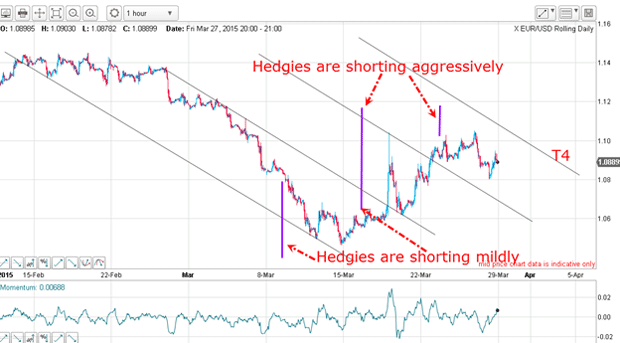My surgical strike in the euro
Swing trader John C Burford takes advantage of a temporary weakness in the very old and tired euro bear trend for a tasty 400-pip profit.
When markets hit big turning points, hedge funds which comprise the larger group of speculators are generally caught wrong-footed, pointing in the wrong direction with a huge imbalance in holdings of long versus short futures.
In other words, at major lows, they hold a huge plurality of shorts over longs and vice versa. I use this phenomenon to help me identify likely trend changes.
Hedge funds are, in general, trend-followers. If they believe a downtrend remains in place, they will keep shorting it even though a new uptrend may have started. Only when there is undeniable evidence that the trend has changed when the market is trading much higher will they amend their behaviour provided their peers agree!
Subscribe to MoneyWeek
Subscribe to MoneyWeek today and get your first six magazine issues absolutely FREE

Sign up to Money Morning
Don't miss the latest investment and personal finances news, market analysis, plus money-saving tips with our free twice-daily newsletter
Don't miss the latest investment and personal finances news, market analysis, plus money-saving tips with our free twice-daily newsletter
It is usually a career-threatening move for a hedge fund or bank analyst to go against the party line'. Contrarians are not usually rewarded for their independence of thought.
But small traders have the luxury of trading without higher-ups breathing down their necks.
Hedgies only see the euro going down that's good news for swing traders
As the euro has approached parity with the dollar in recent days, the chorus of euro bears has been stridently willing the market down I have even seen forecasts for a 0.85 target, which is precisely where the euro started life as a traded currency in 1999.
At these major changes of trend, examination of the commitment of traders (COT) data becomes extremely useful for a swing trader. That is why I was anticipating last Friday's data on the euro with more interest that usual.
We are lucky to have the COT data on the major US futures markets to give us an accurate breakdown of the long and short holdings of the various groups, speculators and commercials.
Recall last week (Trader postof 23 March), I showed the COT data for the week ending Tuesday 17 March:
| CONTRACTS OF EUR 125,000 | Row 0 - Cell 1 | Row 0 - Cell 2 | Row 0 - Cell 3 | Open interest: 449,508 | ||||
| Commitments | ||||||||
| 56,329 | 250,103 | 7,806 | 348,754 | 101,065 | 412,889 | 358,974 | 36,619 | 90,534 |
| Changes from 10/3/15 (Change in open interest: -46,957) | ||||||||
| -4,942 | 7,759 | -17,385 | -20,896 | -35,105 | -45,223 | -44,731 | -3,734 | -2,226 |
| Percent of open interest for each category of traders | ||||||||
| 12.5 | 55.6 | 1.7 | 77.6 | 22.5 | 91.9 | 79.9 | 8.1 | 20.1 |
| Number of traders in each category (Total traders: 191) | ||||||||
| 49 | 103 | 30 | 48 | 57 | 112 | 176 | Row 8 - Cell 7 | Row 8 - Cell 8 |
Hedge funds were piling into shorts. This is the data one week later (on Tuesday 24 March):
| (Contracts of EUR 125,000) | Row 0 - Cell 1 | Row 0 - Cell 2 | Row 0 - Cell 3 | Open interest: 460,950 | ||||
| Commitments | ||||||||
| 50,148 | 271,111 | 6,291 | 366,788 | 94,933 | 423,227 | 372,335 | 37,723 | 88,615 |
| Changes from 03/17/15 (Change in open interest: 11,442) | ||||||||
| -6,181 | 21,008 | -1,515 | 18,034 | -6,132 | 10,338 | 13,361 | 1,104 | -1,919 |
| Percent of open in terest for each category of traders | ||||||||
| 10.9 | 58.8 | 1.4 | 79.6 | 20.6 | 91.8 | 80.8 | 8.2 | 19.2 |
| Number of traders in each category (Total traders: 240) | ||||||||
| 51 | 104 | 30 | 53 | 55 | 120 | 174 | Row 8 - Cell 7 | Row 8 - Cell 8 |
Hedge fund managers were growing more bearish still. Since last Tuesday, they've swung even more markedly to the bearish side, despite the very large rally off the 13 March low.
That is quite unusual heavy speculator-selling does not normally go hand-in-hand with a decent rally.
Funds are dead-set on a bear market that's how bull markets start
But last week, where the market zoomed higher by 200 pips, hedgies aggressively shorted into the rally. In fact, they increased shorts by over 8% and decreased longs by 14% - a massive vote for this being a normal rally in an ongoing downtrend.

That is how bull markets start. Traders have made big money by shorting euro rallies, so why stop now? After all, Greece is about to be thrown out of the euro and contagion will follow as night follows day; the euro will become worthless trash', as so many said about the dollar back in 2012-2013.
I took a long trade in the 1.06 area, but as I wrote in my 23 March post, "the path won't be smooth". My upside target will not be easy to reach.
That is why I took partial profits at the 1.1030 level last Thursday for a tasty 400 pips profit. I now have my protective stop at break even on the remainder of my position.
Of course, the hedgies may be proved correct and the market could fall to parity and beyond. Anything is possible in the markets. But as a swing trader, I took advantage of a temporary weakness in the very old and tired bear trend and made a good profit in a surgical strike.
That is precisely what swing traders try to do we do not want to bet the farm on a long-range forecast; too many traders lose big money by doing just that.
Consider this: the EUR/USD is trading at the same level it was seven years ago. A long-term investment would today be producing zero gain. But in the meantime, there have been several huge swings, which could have been traded for massive gains. I rest my case.
Get the latest financial news, insights and expert analysis from our award-winning MoneyWeek team, to help you understand what really matters when it comes to your finances.
John is is a British-born lapsed PhD physicist, who previously worked for Nasa on the Mars exploration team. He is a former commodity trading advisor with the US Commodities Futures Trading Commission, and worked in a boutique futures house in California in the 1980s.
He was a partner in one of the first futures newsletter advisory services, based in Washington DC, specialising in pork bellies and currencies. John is primarily a chart-reading trader, having cut his trading teeth in the days before PCs.
As well as his work in the financial world, he has launched, run and sold several 'real' businesses producing 'real' products.
-
 Review: Eden Roc Cap Cana – fun, sun and golf in the Caribbean
Review: Eden Roc Cap Cana – fun, sun and golf in the CaribbeanTravel Eden Roc Cap Cana in the Dominican Republic offers everything from relaxing by the pool to a world-class golf course
-
 Reeves delays cash ISA reform, but savers are not out of the woods yet
Reeves delays cash ISA reform, but savers are not out of the woods yetThe chancellor has reportedly delayed plans to cut the cash ISA limit, which were set to be announced at Mansion House on 15 July, and will take more time to consult with the industry